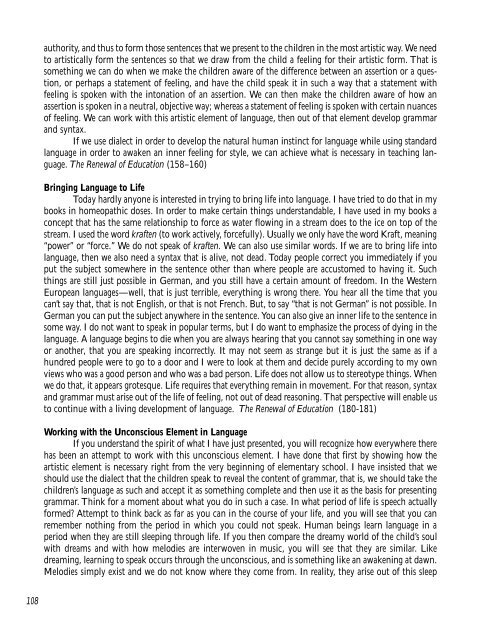Colloquium on English - Research Institute for Waldorf Education
Colloquium on English - Research Institute for Waldorf Education
Colloquium on English - Research Institute for Waldorf Education
Create successful ePaper yourself
Turn your PDF publications into a flip-book with our unique Google optimized e-Paper software.
108<br />
authority, and thus to <strong>for</strong>m those sentences that we present to the children in the most artistic way. We need<br />
to artistically <strong>for</strong>m the sentences so that we draw from the child a feeling <strong>for</strong> their artistic <strong>for</strong>m. That is<br />
something we can do when we make the children aware of the difference between an asserti<strong>on</strong> or a questi<strong>on</strong>,<br />
or perhaps a statement of feeling, and have the child speak it in such a way that a statement with<br />
feeling is spoken with the int<strong>on</strong>ati<strong>on</strong> of an asserti<strong>on</strong>. We can then make the children aware of how an<br />
asserti<strong>on</strong> is spoken in a neutral, objective way; whereas a statement of feeling is spoken with certain nuances<br />
of feeling. We can work with this artistic element of language, then out of that element develop grammar<br />
and syntax.<br />
If we use dialect in order to develop the natural human instinct <strong>for</strong> language while using standard<br />
language in order to awaken an inner feeling <strong>for</strong> style, we can achieve what is necessary in teaching language.<br />
The Renewal of Educati<strong>on</strong> (158–160)<br />
Bringing Language to Life<br />
Today hardly any<strong>on</strong>e is interested in trying to bring life into language. I have tried to do that in my<br />
books in homeopathic doses. In order to make certain things understandable, I have used in my books a<br />
c<strong>on</strong>cept that has the same relati<strong>on</strong>ship to <strong>for</strong>ce as water flowing in a stream does to the ice <strong>on</strong> top of the<br />
stream. I used the word kraften (to work actively, <strong>for</strong>cefully). Usually we <strong>on</strong>ly have the word Kraft, meaning<br />
“power” or “<strong>for</strong>ce.” We do not speak of kraften. We can also use similar words. If we are to bring life into<br />
language, then we also need a syntax that is alive, not dead. Today people correct you immediately if you<br />
put the subject somewhere in the sentence other than where people are accustomed to having it. Such<br />
things are still just possible in German, and you still have a certain amount of freedom. In the Western<br />
European languages—well, that is just terrible, everything is wr<strong>on</strong>g there. You hear all the time that you<br />
can’t say that, that is not <strong>English</strong>, or that is not French. But, to say “that is not German” is not possible. In<br />
German you can put the subject anywhere in the sentence. You can also give an inner life to the sentence in<br />
some way. I do not want to speak in popular terms, but I do want to emphasize the process of dying in the<br />
language. A language begins to die when you are always hearing that you cannot say something in <strong>on</strong>e way<br />
or another, that you are speaking incorrectly. It may not seem as strange but it is just the same as if a<br />
hundred people were to go to a door and I were to look at them and decide purely according to my own<br />
views who was a good pers<strong>on</strong> and who was a bad pers<strong>on</strong>. Life does not allow us to stereotype things. When<br />
we do that, it appears grotesque. Life requires that everything remain in movement. For that reas<strong>on</strong>, syntax<br />
and grammar must arise out of the life of feeling, not out of dead reas<strong>on</strong>ing. That perspective will enable us<br />
to c<strong>on</strong>tinue with a living development of language. The Renewal of Educati<strong>on</strong> (180-181)<br />
Working with the Unc<strong>on</strong>scious Element in Language<br />
If you understand the spirit of what I have just presented, you will recognize how everywhere there<br />
has been an attempt to work with this unc<strong>on</strong>scious element. I have d<strong>on</strong>e that first by showing how the<br />
artistic element is necessary right from the very beginning of elementary school. I have insisted that we<br />
should use the dialect that the children speak to reveal the c<strong>on</strong>tent of grammar, that is, we should take the<br />
children’s language as such and accept it as something complete and then use it as the basis <strong>for</strong> presenting<br />
grammar. Think <strong>for</strong> a moment about what you do in such a case. In what period of life is speech actually<br />
<strong>for</strong>med? Attempt to think back as far as you can in the course of your life, and you will see that you can<br />
remember nothing from the period in which you could not speak. Human beings learn language in a<br />
period when they are still sleeping through life. If you then compare the dreamy world of the child’s soul<br />
with dreams and with how melodies are interwoven in music, you will see that they are similar. Like<br />
dreaming, learning to speak occurs through the unc<strong>on</strong>scious, and is something like an awakening at dawn.<br />
Melodies simply exist and we do not know where they come from. In reality, they arise out of this sleep

















